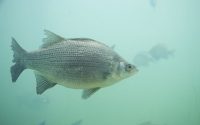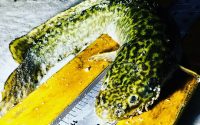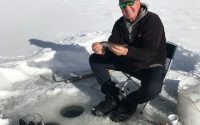Wintertime Stripers!

Ice fishing takes a back seat when the “winter thaw” arrives and Lake Powell (and her siren call) beckons me to chase winter stripers. Though the groundhog saw his shadow and predicted six more weeks of snow and ice, just 4.5 hours south of Provo is “America’s Playground” – with few if any visitors.
Several years ago, Brent Daybell (a good friend from West Jordan), and I began fishing Lake Powell in late January to (hopefully) fill the freezer with stripers caught in the backs of deep canyons in 40 to 80 feet of water using jigging spoons. We decided that Thursday and Friday of last week would be perfect so we grabbed our gear, and headed to Bullfrog.
Weather and Willing Fish
Two specific conditions dictate the success or failure of such adventures. First, the weather must be calm, clear, and “warming.” Though it was 28 degrees when we arrived at the boat ramp, both days warmed into the 50s by early afternoon. The second condition is finding willing fish, active and ready to bite.
We took Brent’s boat this trip so I packed my warmest clothing and was prepared for a 60 mile-per-hour trip north from Bullfrog to find fish. Our first two stops (despite our best efforts) were disappointments. We started in the Knowles Canyon area 15 miles north of Bullfrog and our fish finders didn’t mark any shad nor stripers at all.
Undaunted, we continued north to the muddy Colorado River (below Trachyte Canyon) another 35 miles upstream. It was there, in Two Mile Canyon that we first began to spot both shad and stripers on our graphs. From past experience, we knew that thin, 1/2-ounce white, silver, or pearl spoons would be the most consistent lures so when we finally found a school of stripers under the boat, we simply dropped our spoons directly on top of the schools, hoping to “wake” them up and start a feeding frenzy.
The first schools located were 65 feet below the surface but were not actually on the bottom. Suspended stripers are fun to catch because if you watch your finder as you drop your lure, the lure will be visible as it falls which means it can be stopped in the middle of the suspended schools. Although not eager to bite, we were still able to catch 10 great stripers as we worked our way back down the lake. The fish were healthy and averaged around three pounds each, but we truly struggled to get the schools to eat.
After checking a dozen canyons, we determined the large schools of active stripers were nowhere to be found, so we made our way back to Bullfrog and settled into our cozy motel room, licked our wounds, and prepared for Friday.
The Key to Success
Friday morning was a tiny bit colder but we headed back north to the best canyon we found the previous day. Once there, we immediately began catching aggressive stripers in 35 to 55 feet of water. The key was to go towards the back of the canyons until the water depth went from 80 to 50 feet (or similar depths). The stripers sat just off the edge of the drop off (on the deep side) and were waiting for the shad to swim over the edge.
We quickly caught 12 stripers and found ourselves in the very back of a small, deep canyon. Brent decided to try something different so he tied on a Lucky Craft Staysee 90 (a deep diving jerkbait) and threw it to the bank in less than 10 feet of water. On his first cast, a striper “slammed” his lure and for the rest of the day, both of us boated a couple of dozen awesome stripers using jerkbaits.
If you don’t want to wade through the slush on your favorite ice fishing haunt, get the boat out of moth balls and head to Lake Powell for some great wintertime striper action. This kind of fishing should hold up the entire month of February. Give it a try!










